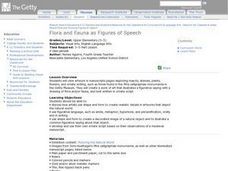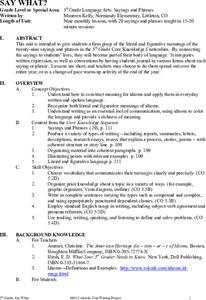Curated OER
It's Raining Cats and Dogs! Literary Devices and Figurative Language
Third and fourth graders study literary devices and figurative language. They view a PowerPoint presentation (which you must create) to review hyperbole, idiom, simile, and metaphor. They read and discuss the book There's A Frog in My...
Curated OER
Flora and Fauna as Figures of Speech
What a lovely way to incorporate artwork into your language arts lesson plan. View artwork in illustrated manuscript pages, depicting insects, animals, plants, flowers, and ornate writing in the Getty Museum. Practice using figurative...
Curated OER
Figurative Language
Students interpret figurative language. In this language lesson, students are read the poem "I Love the Look of Words" by Maya Angelou and are to find examples of hyperbole and personification in the poem. Students then rotate among...
K12 Reader
Animal Proverbs and Adages
What will play when the cat's away? Practice figurative language with a list of proverbs about animals. Kids use the word bank at the top of the page to fill in the blanks based on their knowledge of common phrases.
Curated OER
Comparisons: Well-Known Sayings
How familiar is your class with basic idioms? Eight idioms and their explanations are listed here, and learners must match each explanation with the correct idiom. Looking for a way to extend this activity? Have your learners choose one...
EngageNY
Contrasting Two Settings (Chapter 6: "Lost Melones/Cantalouples")
Continue working through Esperanza Rising, by Pam Munoz Ryan, by looking into language choices and discussing text-dependent questions. Pupils converse in small groups and as a class about plot, setting, and figurative language. Using...
Curated OER
Proverbs & Old Sayings
How familiar is your class with proverbs? There are 23 proverbs listed here, and the goal is to name the missing word in each sentence. Find the answer easily by clicking the drop down that says answer. Some of them are easy, and some...
Curated OER
Sayings Quiz: Mixed 1
In this English sayings worksheet, students complete a ten question multiple choice online interactive quiz about the meaning of common sayings. Example: A bad penny always turns up.
Curated OER
English Expressions Quiz: Online
An online worksheet provides opportunities to assess comprehension of 10 common adages like "A bird in the hand is worth two in the bush" or "Variety is the spice of life." Learners complete a multiple choice quiz (and can check their...
Curated OER
Say It with Meaning: Applying Sayings and Phrases
Students complete a unit of lessons on well known sayings and phrases. They create a journal, write paragraphs, sequence events, and analyze key vocabulary for various sayings and phrases throughout the school year.
K12 Reader
If
Rudyard Kipling's advice to his son in the poem "If" is a resounding message that echoes through generations. After reading the famous poem, middle schoolers work on analyzing specific lines, completing activities based on unfamiliar...
K12 Reader
Proverbs and Adages: What Do They Mean?
You shouldn't judge a book by its cover, but feel free to find the silver lining in a worksheet about common proverbs and adages. Learners read six popular adages and write their literal definitions on the lines provided.
Curated OER
Country Sayings Exercise
In this idioms activity, students read 12 country expressions or colloquial expressions and then match each with its correct meaning, Students then write down 3 colloquial expressions or idioms from their language and record the meanings.
Curated OER
Metaphor
High schoolers identify the distinction between literal and figurative language with a focus on metaphors. They complete a metaphor analysis chart, then practice expanding metaphors by composing their own comparisons of elements of the...
Curriculum Corner
ELA Common Core Checklists for K-6
In the hustle and bustle of life in the classroom, it's easy for teachers to lose track of the standards they have taught, and those that still need to be addressed. This Common Core checklist provides educators with an easy-to-use...
Curated OER
Cultural Sayings - Idioms
In this grammar worksheet, students read the definition and an example of idioms or cultural sayings. They work on-line to match 14 idioms with their true meanings.
Curated OER
Heavens to Betsy There Sure are a Lot of Sayings!!
Students explore a variety of sayings and phrases used in the English language in the seventeen lessons of this unit. Through visual, auditory, and kinestic activities, students are immersed in the study of the English language.
Curated OER
Formal versus Informal Language
Engage in an activity that focuses on the concepts of formal and informal language use. Middle and high schoolers compare and contrast each style by using a Venn diagram that includes some examples. They read and hear a passage of lyrics...
Curriculum Corner
“I Can” Common Core! 3rd Grade Language
Support third graders with developing their language skills using this Common Core checklist. With each standard written as an I can statement, children are given clear learning goals to work toward throughout the year.
Curated OER
Say What?
Students explore the literal and figurative meanings of twenty-nine phrases and sayings. This unit of nine lessons integrates written expression and convention to demonstrate the value of idioms to the language.
Curated OER
You Don't Say!!
Fourth graders write and respond to sayings throughout the school year. They define the idioms, illustrate them and compare their meanings with other groups in the class.
Curated OER
The Kindergarten Book of Sayings
Students create a book of sayings. In this oral language lesson, students record common sayings or idioms into a book. Students discover the meaning behind each saying.
K12 Reader
Proverbs and Adages: What’s the Meaning?
Your kids have probably heard these idioms before, but do they know what they mean? Help them learn that haste makes waste, an ill wind blows no good, and that ignorance is bliss with a list of popular expressions.
Shmoop
ELA.CCSS.ELA-Literacy.RL.9-10.1
Does your ELA class need some practice with the specific skills outlined in the Common Core standards? Then this is the perfect resource for you! One in a series of connected lessons that cover the standards for reading literature,...

























